Microsoft Teams enables meetings with up to 1,000 participants. This vast capacity is perfect for large conferences, general team meetings for large organizations, and important company-wide presentations.
However, at CoffeePals, we are all about collaboration and relationship building. A 1,000-person call is not ideal for encouraging active participation, hearing feedback from a range of attendees, and fostering cross-departmental collaboration.
Microsoft Teams breakout rooms are the perfect solution to this problem, as they allow for smaller groups within a larger meeting to form, meet, talk, and report back to the larger group. Many managers are wondering how to create breakout rooms in teams, and we have your complete guide here.
This article will outline:
- What MS Teams breakout rooms are
- Why they are important
- How to do breakout rooms in Teams
- How to enhance collaboration and communication in Microsoft Teams
- How to spark a conversation among your employees today
What are breakout rooms?
Microsoft Teams’ breakout room feature offers a side meeting for a subset of participants in a larger call.
Imagine you are hosting a full team meeting with 50+ employees. Team leaders can set up breakout rooms for groups of 5 and assign each group a specific topic to discuss.
When the host of the call moves the participants to their breakout room, they will experience being moved to a smaller call, with only their subgroup, until the host reconvenes all attendees into the main meeting again.
Ultimately, breakout rooms give managers, teachers, and other users of Microsoft Teams the option to create strategic smaller meetings in a virtual setting for specific discussion purposes.
Why are breakout rooms important?
If you are sitting in a crowd of 100 people, how likely is it that you will participate? Now, think about the virtual context where many meeting attendees may be muted, have their camera off, or be multitasking and checking their email at the same time.
In virtual meetings, the leaders and hosts often do most of the talking. Breakout rooms help solve this issue and allow individuals to participate in smaller groups.
These rooms can foster collaboration, improve business outcomes by hearing insight from all employees, and provide team members with a more fulfilling and engaging meeting experience.
How to create and manage breakout rooms
Here’s our step-by-step guide on how to enable breakout rooms in Teams.
Tips before you get started
To create the rooms, you will need to be a meeting organizer using the desktop app. You will need to be present for the entire meeting and won’t be able to pass over the hosting position to a different user. So, make sure you are making the rooms from the correct account.
There is also an option to create the team breakout session during the meeting, but the process follows similar steps.
Before the meeting begins
Go to the meeting invitation within the Teams calendar and navigate to the Breakout rooms tab. Indicate the number of rooms you want to create, depending on the meeting size, and assign participants to each room. There are two options:
- Automatic assignment: The program will equally distribute attendees to the rooms at random.
- Manual assignment: The host can place members into rooms one by one.
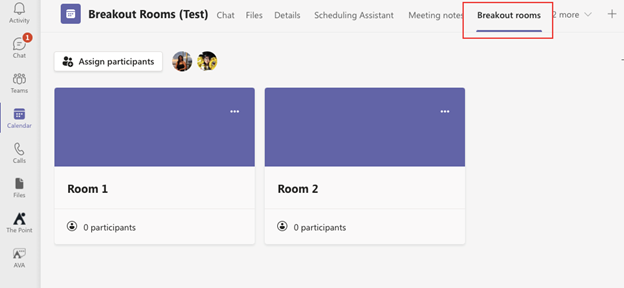
Midway through the meeting
If you decide you want to create breakout rooms once you are already in the meeting, click the breakout rooms icon and follow the same steps as above by either randomly or manually assigning participants. Finally, hit “create rooms” to finalize your choice.


How to manually assign participants
After you select to manually assign all the meeting participants, just know that you won’t be able to go back and re-select to have Teams automatically assign the rooms instead.
When you choose manual, the program will show a list of everyone attending the meeting, and you can go through one-by-one, selecting which room you would like to add them to in the ‘Room’ drop down. You can also bulk-sort by using the check box to the left of their picture to assign full groups at a time.
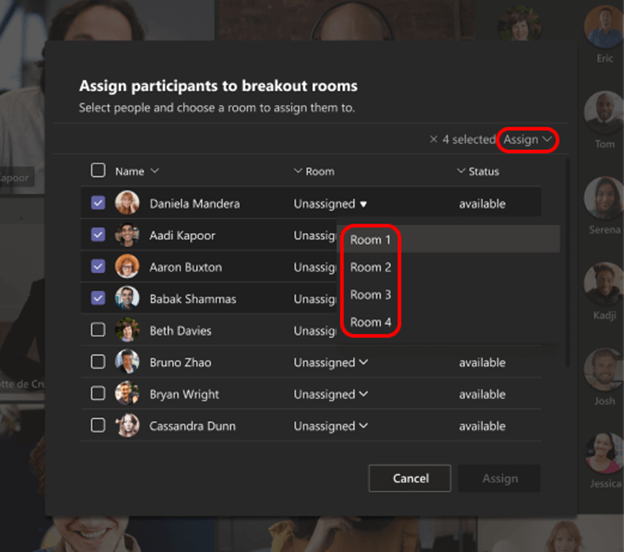
If someone joins the meeting later, you can go back into the ‘Assign Participants’ screen and manually place them into the room of your choice.
Assign room leaders
Creating breakout room managers means appointing an individual who can share manager duties. However, it is important to note that assigning these leaders does not mean the original host can leave the call.
These individuals can add and delete rooms, reassign participants, join any room, set room time limits, and send announcements.
- To assign managers in advance: Go to the ‘Room Settings’ section of the breakout rooms tab and turn on the option to ‘Assign presenters to manage rooms.’ From there, search for the individual you want to assign.
- To assign managers during the meeting: Click the same Breakout rooms icon that you would click to make rooms and follow the same steps as if you were assigning managers in advance.
Note that you will only be able to have one manager in control of a given room at any time, and you will be able to see who is in charge of each room.
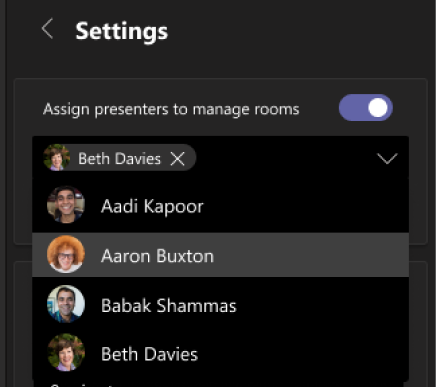
Renaming rooms
Select the breakout rooms icon and click ‘More options.’ It will show you the rooms with their default names, which will be Room 1, Room 2, etc. You can click ‘Rename room’ and customize the title for each breakout space according to topic, group, team, and more.
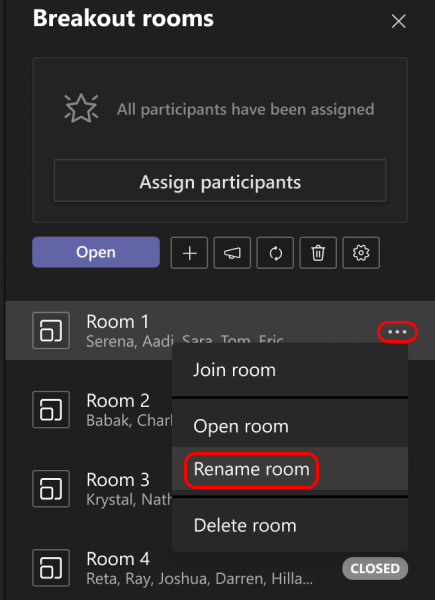
For team managers: How to join a breakout room
By navigating to the breakout rooms icon, managers and hosts can see a list of the rooms in operation, select ‘More options’ next to the room they want to join, and select ‘Join room.’ Similarly, click ‘Return’ to the meeting in the controls panel to exit the room.
How to send a notification to all breakout rooms
As the manager, you can send announcements to all the breakout rooms at once, which is useful when communicating a 5-minute warning or distributing useful materials and references. After clicking the breakout room button, you can select ‘Make an announcement,’ which will disseminate to every participant when you hit send.
Chatting with members of breakout rooms
A separate chat is assigned to each breakout room, and within the overall Teams Chat list, you will see the rooms listed. By clicking on an individual room, you can send chats to all the members of that room without sending the messages to all the rooms at once, as with the previous example.
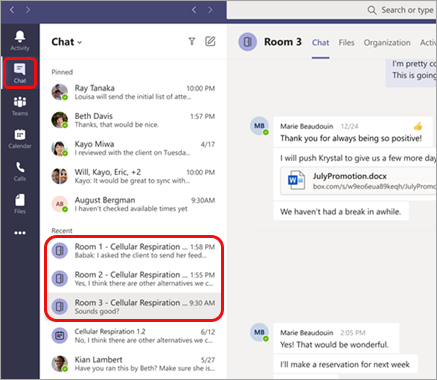
How to close, leave, and end the breakout room sessions
Closing the breakout rooms automatically returns participants into the main, larger meeting. It does not end the overall meeting for everyone.
There are two options when it comes to closing meeting rooms:
- Closing singular and individual rooms: Click on the breakout rooms button, navigate to the particular room, select ‘More options’ and click ‘Close room’ for each specific room that you want to end.
- Closing all rooms at once to return to the larger group: Click the breakout rooms button and just hit ‘Close.’ You will then see all team members return to the larger meeting, and you can click ‘Resume’ to restart the overall meeting when you see everyone has left their breakout room.
How to take collaboration to the next level in Microsoft Teams
Using our CoffeePals app, you can continue the advantages of breakout rooms in Teams by fostering communication, collaboration, and relationship building. Our program helps teams create meaningful connections while working remotely by creating opportunities for spontaneous and genuine interaction.
We help teams with onboarding, colleague meet-and-greets, mentoring sessions and morale by randomly or deliberately assigning small group hangouts and sending prompts with discussion topics and questions to get team members talking.
Spark a conversation with your employees through Microsoft Teams
CoffeePals encourages participation between team members who may not know each other well and offers the chance to spontaneously learn about colleagues—a feature missing from the remote workplace.
Using our tools, you will help coworkers spark new conversations, feel more connected, and work more productively with other team members. The benefits of employee relationships are felt at all levels of the organization.
Make the most of your Microsoft Teams integration by using our plug-in. Explore our packages to try them out.










